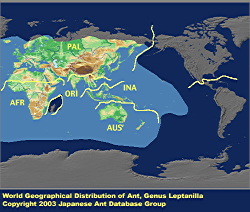
|
genus
|
Leptanilla
|
 |
Japanese Name
|
Mukashi-ari-zoku
|
Original Reference
|
|
Emery, C. (1870) Studi mirmecologici. Bullettino della Societą Entomologica Italiana 2: 193-201.
|
Synonym
|
|
Leptomesites Kutter, 1948
|
Description
|
|
Minute ants: total length of workers around 1 mm in most species. Body color yellowish- reddish-brown. Body elongate and flattened in general shape. Eyes absent. Antennal insertions exposed, without frontal lobes. Antennae 12-segmented; scape rather thick, short, not reaching posterior margin of head; funiculus not clavate. Mesosoma depressed, promesonotal suture complete and flexible. Petiole sessile. Postpetiole well separated from gaster in worker, but not differentiated in female and male. Female wingless (dichthadiiform), mesosomal sclerites fused as in worker. Male small, wing venation vestigial, with only Sc + R + Rs veins.
|
|

|
Remarks
|
|
Leptanilla lives in the soil. Workers actively vibrate their antennae when ambulatory. These ants have been said to be nomadic mass-foragers like the aenictines, dorylines and ecitonines, but little is known in detail concerning their field biology. Masuko (1989) succeeded in maintaining colonies in the laboratory. His ants fed on geophilomorph centipedes. Ogata et al. (1995) reported field observations of this species, and described the males of two unidentified Leptanilla species. Five described and one undescribed species are known from Japan. All are rare.
|
References
|
|
- Kutter, H. 1948. Beitrag zur Kenntnis der Leptanillinae (Hym. Formicidae). Eine neue Ameisengattung aus Süd-Indien. Mitt. Schweiz. Entomol. Ges., 21: 286-295.
- Masuko, K. (1989). Larval hemolymph feeding in the ant Leptanilla japonica by use of a specialized duct organ, the ""larval hemolymph tap"" (Hymenoptera: Formicidae). . Behav. Ecol. Sociobiol., 24, 127-132.
- Ogata, K., Terayama, M. & Masuko, K. (1995). The ant genus Leptanilla: discovery of the worker-associated male of L. japonica, and a description of a new species from Taiwan (Hymenoptera: Formicidae: Leptanillinae). Systematic Entomology, 20: 27-34.
|
Editor
|
|
Original text by Kazuo Ogata. English translation by Kazuo Ogata, edited by Robert W. Taylor. Revised by Masashi Yoshimura.
|
|